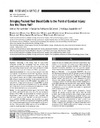Identificador persistente para citar o vincular este elemento:
https://accedacris.ulpgc.es/jspui/handle/10553/42144
| Título: | Bringing Packed Red Blood Cells to the Point of Combat Injury: Are We There Yet? | Autores/as: | Unlu, Aytekin Yilmaz, Soner Yalcin, Ozlem Uyanik, Metin Petrone, Patrizio Cetinkaya, Riza Aytac Eker, Ibrahim Urkan, Murat Ozgurtas, Taner Avci, Ismail Yasar Zeybek, Nazif Aksu, Ali Cenk |
Clasificación UNESCO: | 32 Ciencias médicas | Palabras clave: | Combat trauma Blood transport Prehospital transfusion Hemolysis Harp yaralanmaları, et al. |
Fecha de publicación: | 2018 | Editor/a: | 1300-7777 | Publicación seriada: | Turkish Journal of Haematology | Resumen: | Objective:
Hemorrhage is the leading cause of injury-related prehospital mortality. We investigated worst-case scenarios and
possible requirements of the Turkish military. As we plan to use blood resources during casualty transport, the impact of transport-related mechanical stress on packed red blood cells (PRBCs) was analyzed.
Materials and Methods:
The in vitro experiment was performed in the environmental test laboratories of ASELSAN®. Operational vibrations of potential casualty transport mediums such as Sikorsky helicopters, Kirpi® armored vehicles, and the NATO vibration standard MIL-STD-810G software program were recorded. The most powerful mechanical stress, which was created by the NATO standard, was applied to 15 units of fresh (≤7 days) and 10 units of old (>7 days) PRBCs in a blood cooler box. The vibrations were simulated with a TDS v895 Medium-Force Shaker Device. On-site blood samples were analyzed at 0, 6, and 24 h for biochemical and biomechanical analyses.
Results:
The mean (±standard deviation) age of fresh and old PRBCs was 4.9±2.2 and 32.8±11.8 days, respectively. Six-hour mechanical
damage of fresh PRBCs was demonstrated by increased erythrocyte fragmentation rates (p=0.015), hemolysis rates (p=0.003), and
supernatant potassium levels (p=0.003) and decreased hematocrit levels (p=0.015). Old PRBC hemolysis rates (p=0.015), supernatant
potassium levels (p=0.015), and supernatant hemoglobin (p=0.015) were increased and hematocrit levels were decreased (p=0.015) within
6 h. Two (13%) units of fresh PRBCs and none of the old PRBCs were eligible for transfusion after 6 h of mechanical stress. Conclusion:
When an austere combat environment was simulated for 24 h, fresh and old PRBC hemolysis rates were above the quality
criteria. Currently, the technology to overcome this mechanical damage does not seem to exist. In light of the above data, a new
national project is being performed. Amaç: Kan kayıpları, hastane öncesi dönemdeki yaralanmalara bağlı ölümlerin en sık sebebidir. Türk ordusu için en kötü senaryoları ve olası ihtiyaçları araştırdık. Çatışma alanından nakil esnasında kan kaynaklarını kullanmayı planladığımız için nakil işleminden kaynaklı mekanik stresin eritrosit konsantreleri üzerine etkisini analiz edilmiştir. Gereç ve Yöntemler: İn vitro çalışmalar ASELSAN®’ın dış ortam test laboratuvarlarında gerçekleştirildi. Çatışma alanında kan taşıma işleminde kullanılması muhtemel olan Sikorsky helikopteri ve Kirpi® araçlarının operasyonel vibrasyonları ve NATO MIL-STD-810G titreşim standart yazılımı kayıt altına alındı. NATO standardının en güçlü titreşime neden olduğu hesaplandı. Kan saklama çantası içindeki 15 ünite taze (≤7 gün) ve 10 ünite taze olmayan eritrosit konsantresi (>7 gün), NATO standardı olan mekanik strese maruz bırakıldı. Titreşim TDS v895 Medium-Force Shaker cihazı tarafından simüle edildi. Simülasyonun 0., 6. ve 24. saatinde biyokimyasal ve biyomekanik analiz için kan örnekleri alındı. Bulgular: Taze ve taze olmayan eritrosit konsantreleri sırasıyla ortalama 4,9 [standart deviasyon (SD) ±2,2] ve 32,8 (SD ±11,8) günlüktü. Taze eritrosit konsantrelerinde 6. saatte gelişen mekanik hasar; artmış eritrosit fragmentasyonu (p=0,015), hemoliz oranı (p=0,003) ve supernatant potasyum (p=0,015) düzeyleri ile gösterildi. Taze olmayan eritrosit konsantrelerinin 6. saatte hemoliz oranı (p=0,015) ve supernatant potasyum düzeyi (p=0,015) yükselirken, hematokrit değerleri (p=0,015) düştü. İlk 6 saat içerisinde taze eritrosit konsantrelerinin 2’si (%13) transfüze edilebilir kalitede kalırken, taze olmayanların ise hiçbirisi uygun değildi. Sonuç: Taze ve taze olmayan eritrosit konsantrelerinin hemoliz oranları, bu ürünleri muharebe sahasında taşıdığımızda, çoğunun kullanılamaz hale geleceğini göstermektedir. Halihazırda eritrositler üzerinde oluşan mekanik hasarlanmanın önüne geçebilecek bir teknoloji bulunmamaktadır. Yukarıdaki verilerin ışığı altında yeni bir ulusal proje gerçekleştirilmektedir. |
URI: | https://accedacris.ulpgc.es/handle/10553/42144 | ISSN: | 1300-7777 | DOI: | 10.4274/tjh.2018.0081 | Fuente: | Turkish Journal of Haematology [ISSN 1300-7777], v. 35 (3), p. 185-191 |
| Colección: | Artículos |
Citas SCOPUSTM
3
actualizado el 08-jun-2025
Citas de WEB OF SCIENCETM
Citations
3
actualizado el 08-jun-2025
Visitas
77
actualizado el 17-ago-2024
Descargas
89
actualizado el 17-ago-2024
Google ScholarTM
Verifica
Altmetric
Comparte
Exporta metadatos
Los elementos en ULPGC accedaCRIS están protegidos por derechos de autor con todos los derechos reservados, a menos que se indique lo contrario.
